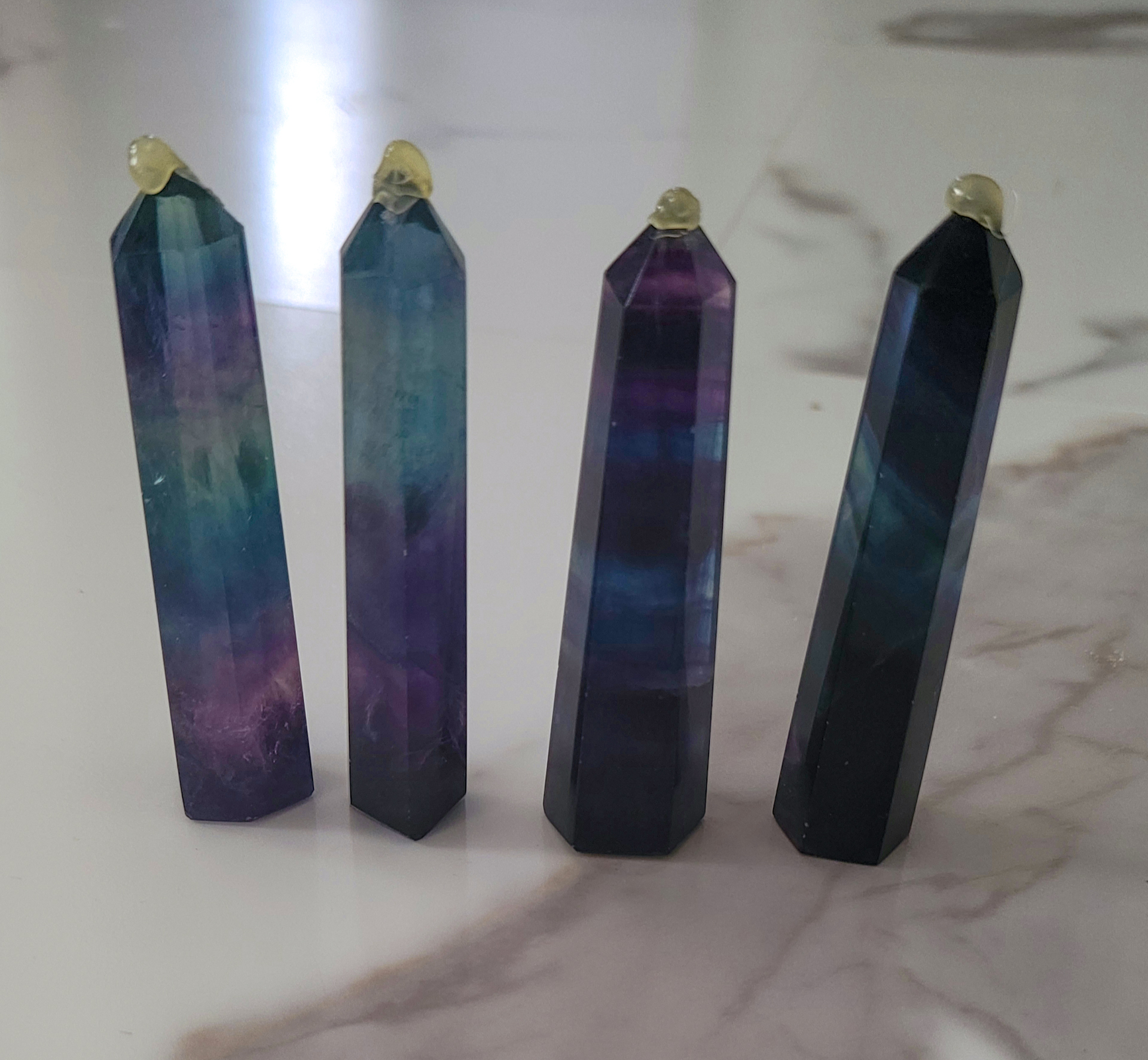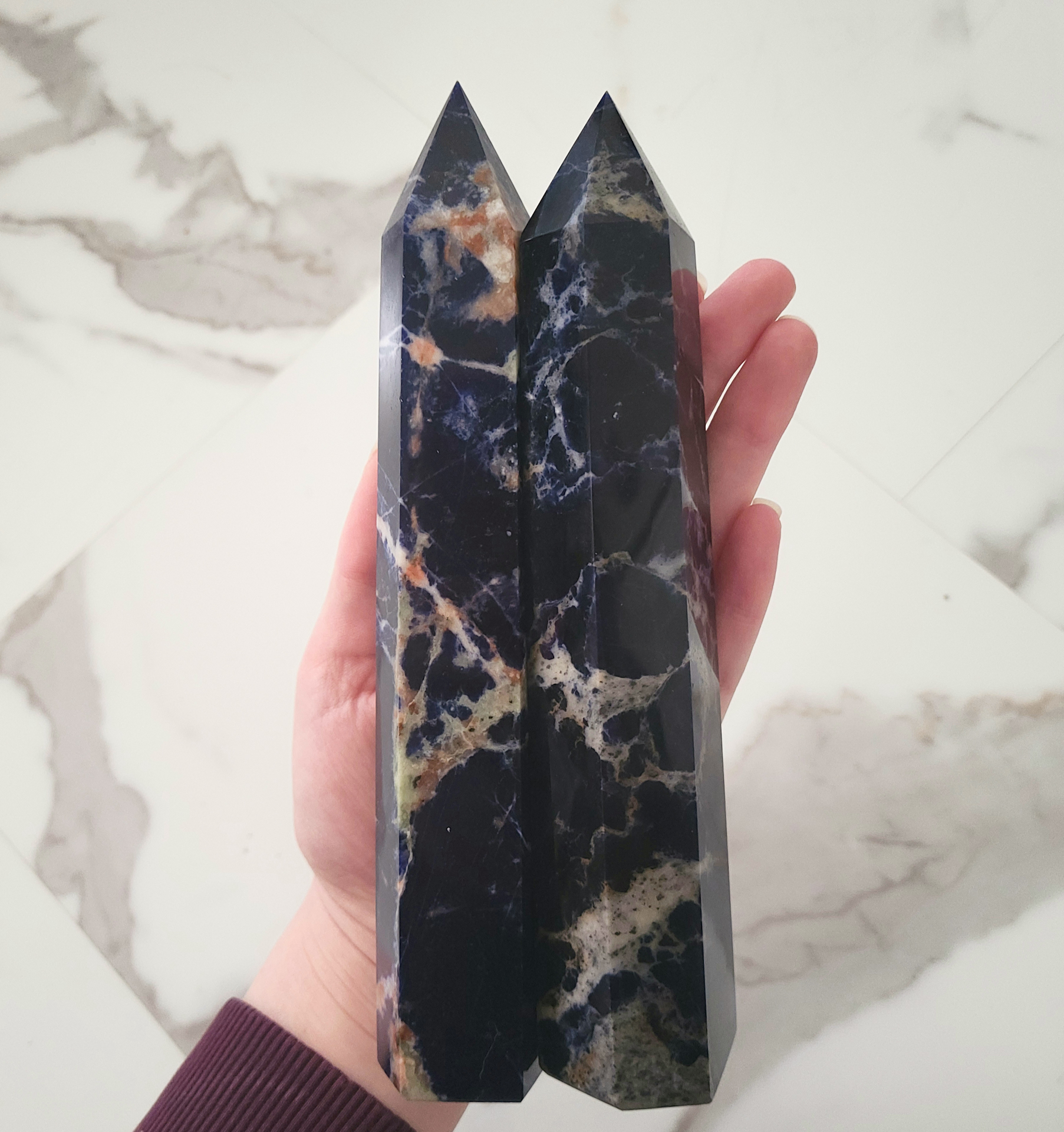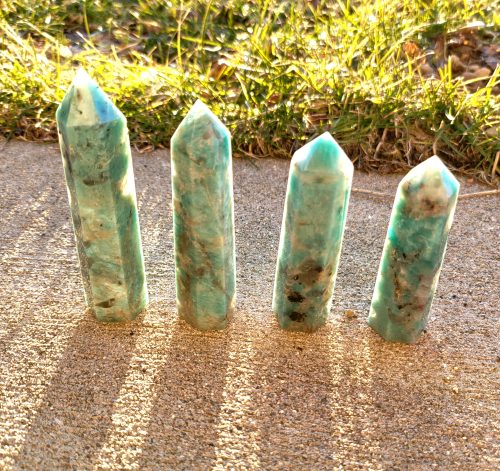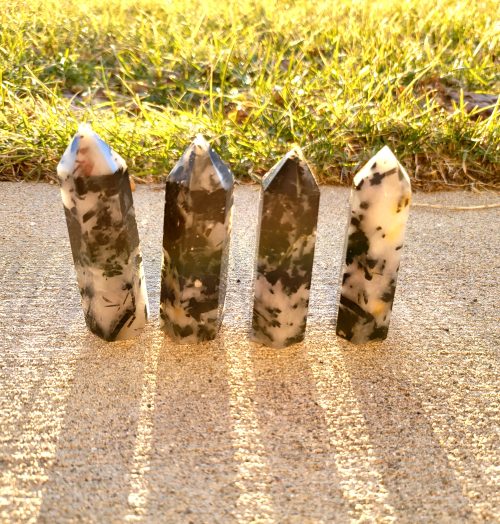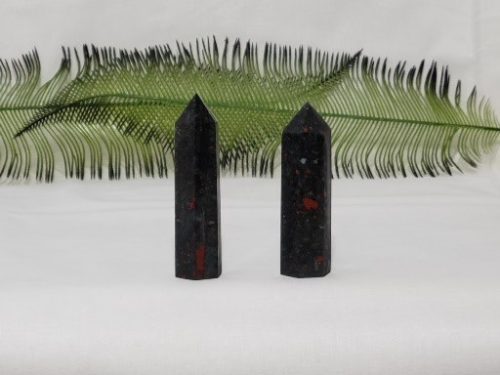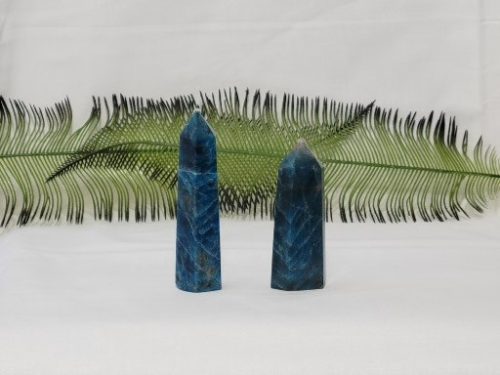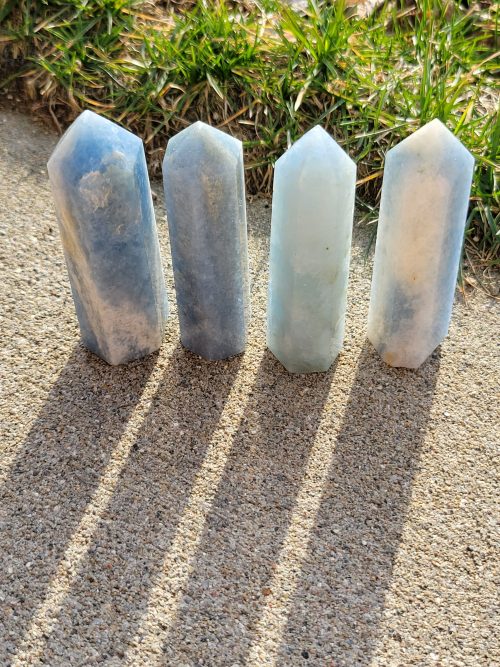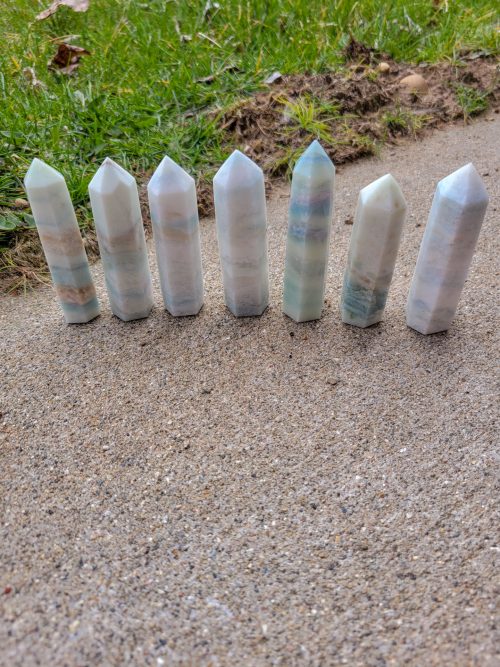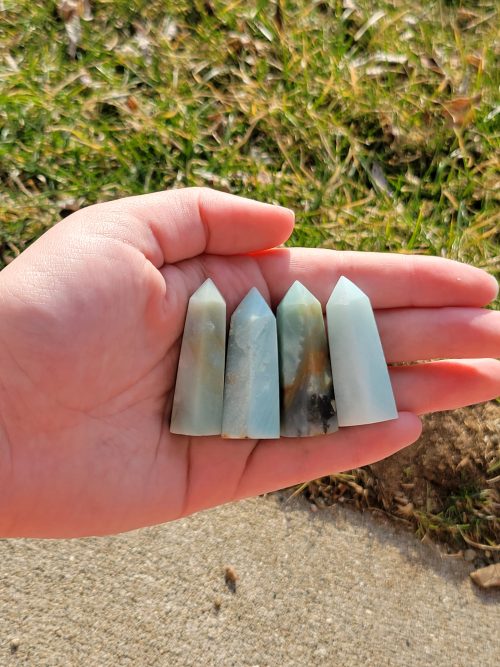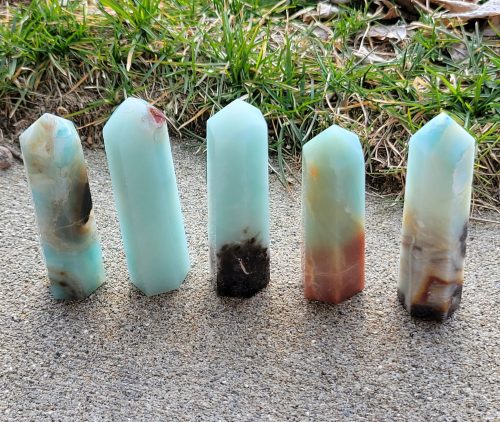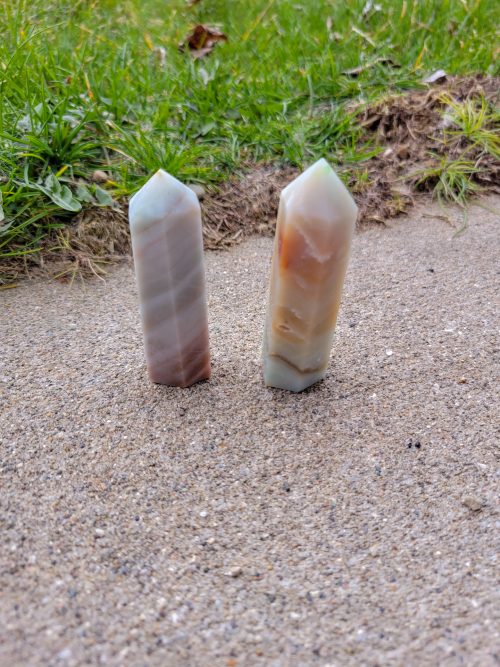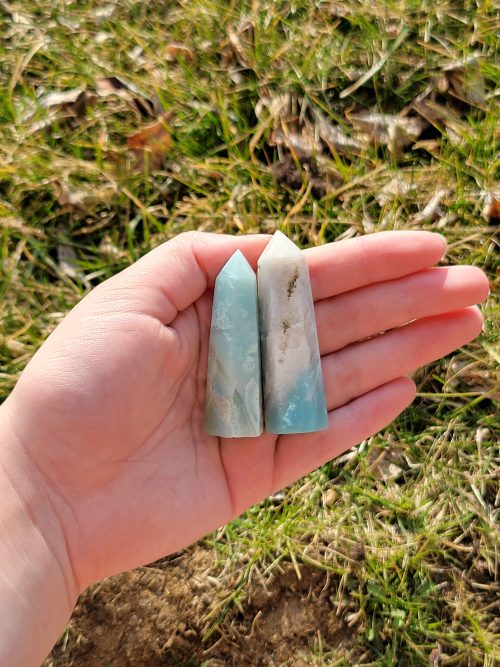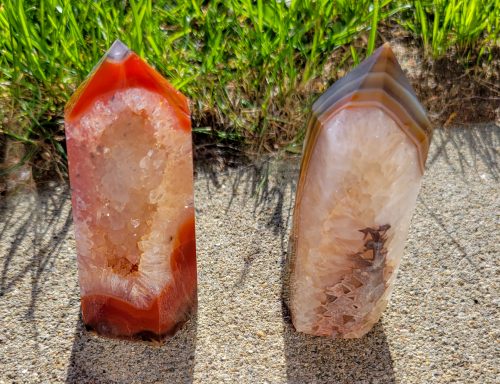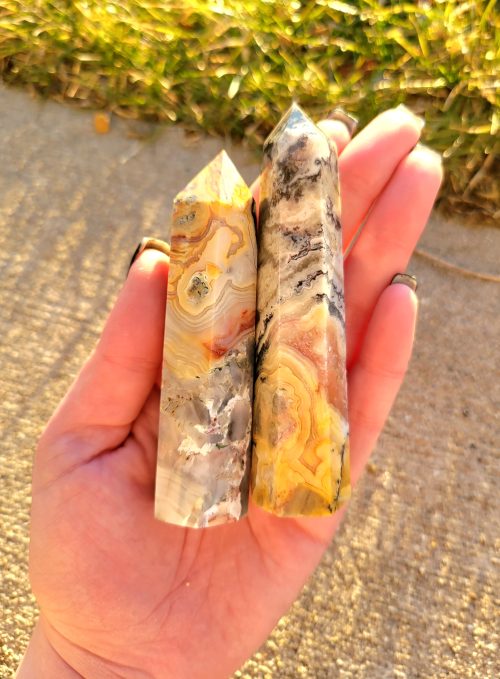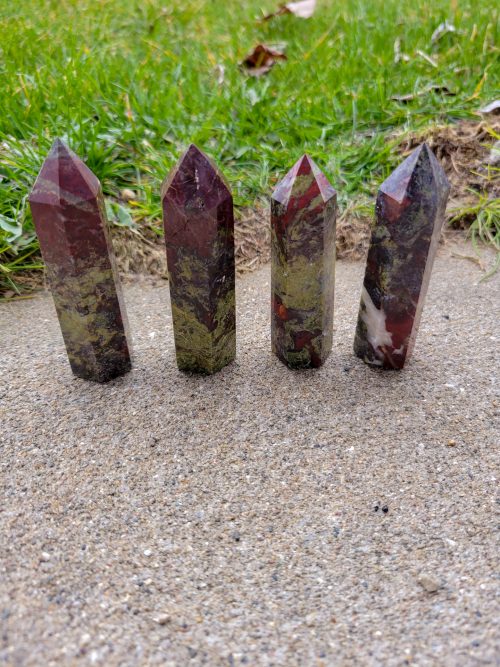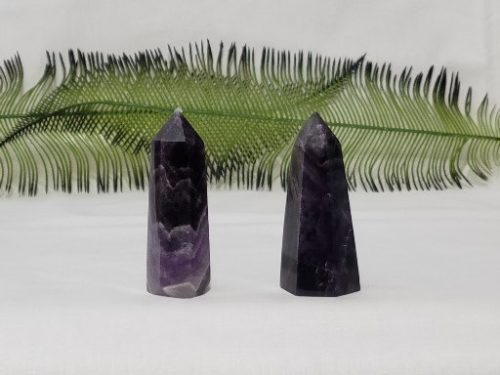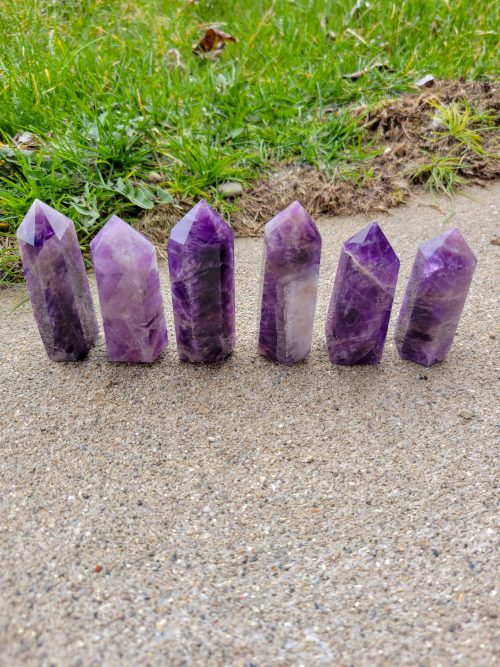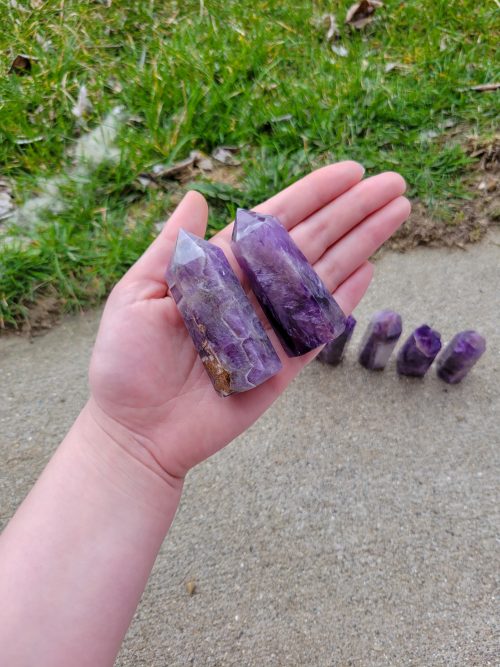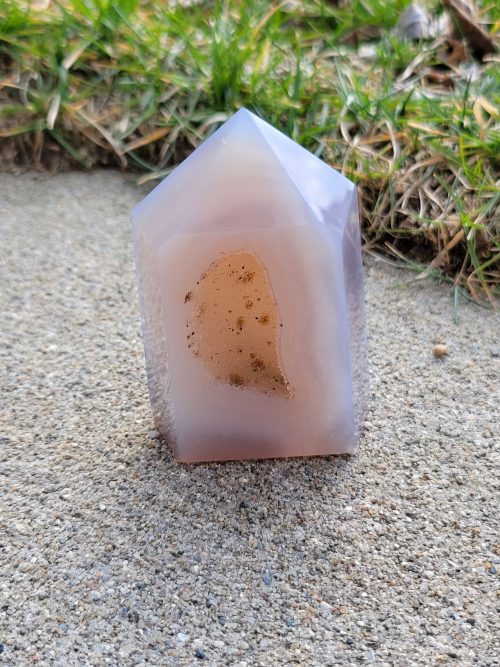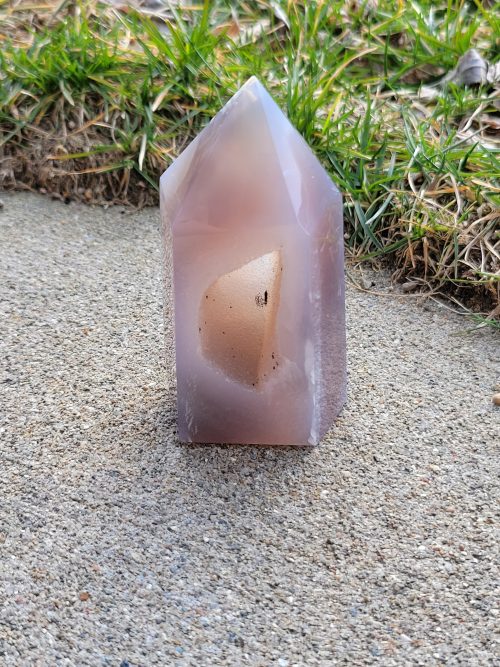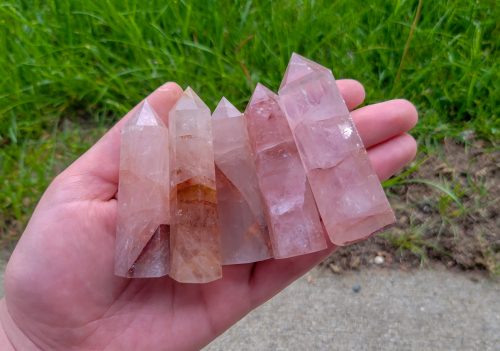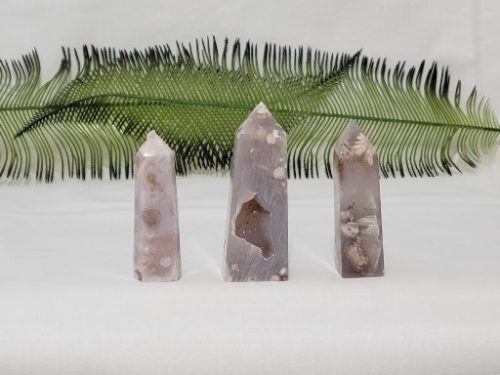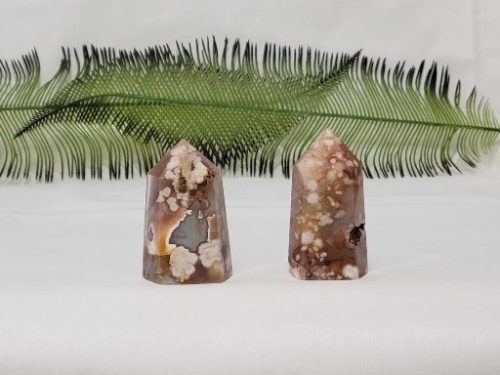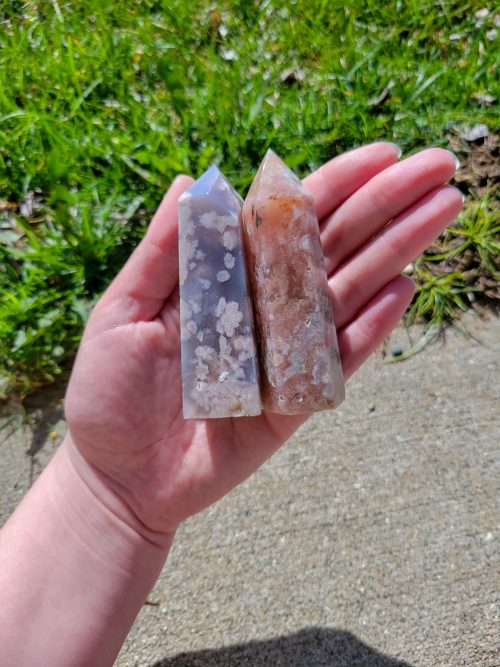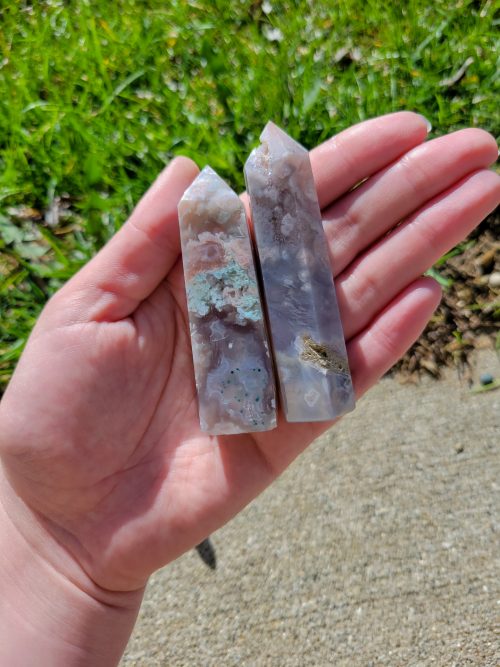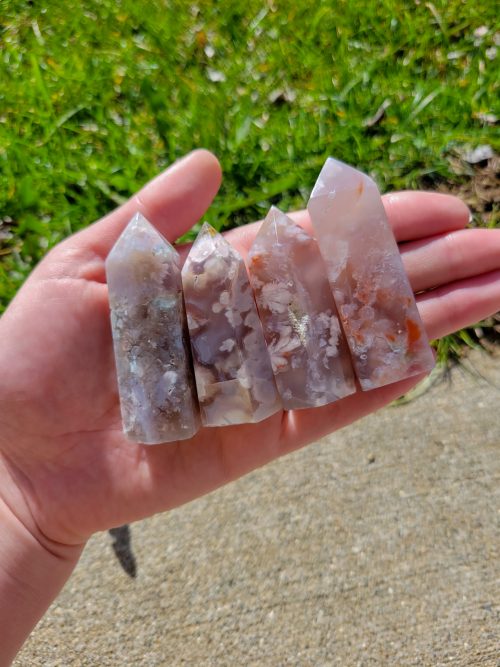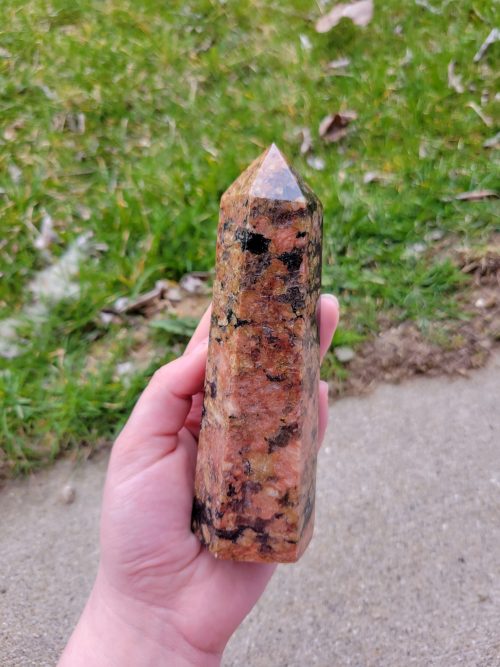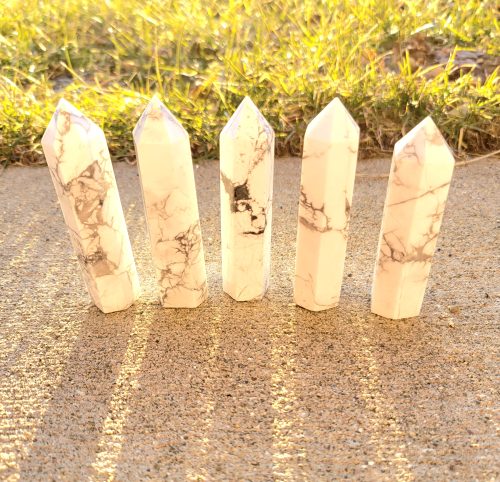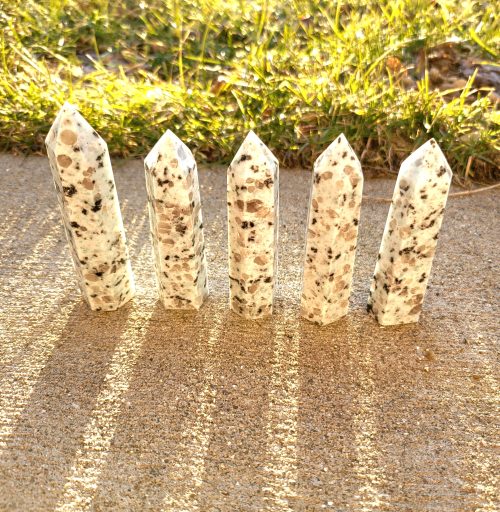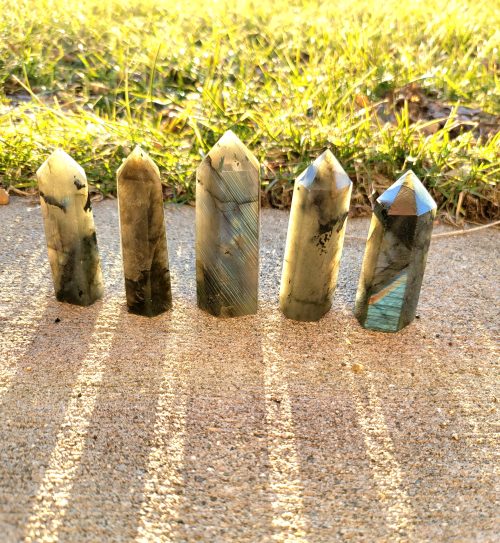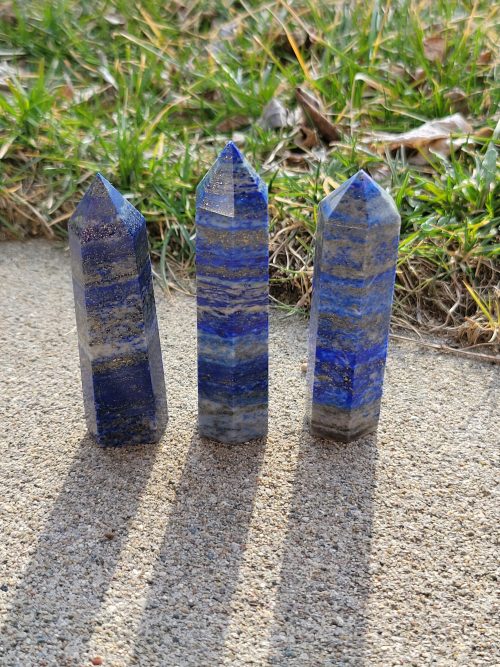-
2 x 1 x 7cm Fluorite is composed of fluorine and calcium and is formed in hydrothermal veins in the Earth's crust. This mineral can be found in all colors of the rainbow with different hues. The different colors in Fluorite are caused by impurities within the mineral. The deeper colors are found in well-formed crystals. Fluorite was originally discovered in Illinois in 1842 but is no longer mined in the US. It can be found in China, South Africa, Mongolia, France, and Russia. ***Due to natural variations in stones, the appearance will vary***
-
4 x 3 x 20cm Sodalite is a rare mineral formed inside igneous rocks crystalized as a result of sodium-rich magma. The blue color comes from the rock that Sodalite is formed in; nepheline syenite, trachyte, and phonolite. Although the sodalite-bearing rock is rare, it can most commonly be found in the US, Canada, and Africa. ***Due to natural variations in stones, the appearance will vary***
-
9cm - 10cm Tall Amazonite is a type of feldspar that gets its name from the Amazon River. Geologists once thought the color came from the oxides that come off of copper. In recent studies, geologists suggest this stone gets its color from the lead and water contents that are found within its contents. Originally found in Brazil, these beautiful rocks can also be found in Madagascar. There have also been findings of this crystal in Colorado, United States. ***Due to natural variations in stones, the appearance will vary***
-
8cm Tall Amazonite is a type of feldspar that gets its name from the Amazon River. Geologists once thought the color came from the oxides that come off of copper. In recent studies, geologists suggest this stone gets its color from the lead and water contents that are found within its contents. Originally found in Brazil, these beautiful rocks can also be found in Madagascar. There have also been findings of this crystal in Colorado, United States. ***Due to natural variations in stones, the appearance will vary***
-
8cm Tall Tourmaline is a complex family of minerals composed of aluminum borosilicate mixed with magnesium, iron or other metals. Tourmaline can come in a variety of colors depending on its proportion of these components. These colors are red, pink, yellow, brown, green, blue, black, or violet colors. This mineral can be found mainly in Brazil and many parts of Africa. ***Due to natural variations in stones, appearance will vary***
-
10cm Tall Bloodstone is formed, like many other minerals, when molten rock rises to the Earth's surface and cools. Then as gasses escape and settle on the rock's surface, it leaves little pockets on the surface of the mineral. The green color in Bloodstone comes from Chlorite and Amphibole. The red spots are iron oxide deposits where the gasses rose. Most Bloodstone is found in India, Australia, Brazil, and Madagascar. ***Due to natural variations in stones, the appearance will vary***
-
11cm Tall Apatite is formed under sedimentary rocks found in marine environments. In this environment, phosphatic organic debris (such as bones, teeth, scales, and fecal material) mineralizes to form these crystals. These crystals vary from green to blue color. ***Due to natural variations in stones, the appearance will vary***
-
9cm Tall Calcite is a rock-forming mineral that is found throughout the world in sedimentary, metamorphic, and igneous rocks. The blue color comes from the calcium carbonate inclusions within this mineral. Blue calcite can be found in many places around the world but mostly in Mexico, The United States, Britain, and Iceland. ***Due to natural variations in stones, appearance will vary***
-
4.5cm Tall Caribbean calcite is a very new combination mineral that was recently found in 2019 in Pakistan. It's a combination of a very light ocean Blue Calcite and light brown and white aragonite. Although recently discovered, this mineral is not expected to stick around for long unless more deposits are found in other areas. ***Due to natural variations in stones, appearance will vary***
-
5.5cm Tall Caribbean calcite is a very new combination mineral that was recently found in 2019 in Pakistan. It's a combination of a very light ocean Blue Calcite and light brown and white aragonite. Although recently discovered, this mineral is not expected to stick around for long unless more deposits are found in other areas. ***Due to natural variations in stones, appearance will vary***
-
9cm Tall Caribbean calcite is a very new combination mineral that was recently found in 2019 in Pakistan. It's a combination of a very light ocean Blue Calcite and light brown and white aragonite. Although recently discovered, this mineral is not expected to stick around for long unless more deposits are found in other areas. ***Due to natural variations in stones, appearance will vary***
-
7.5cm Tall Caribbean calcite is a very new combination mineral that was recently found in 2019 in Pakistan. It's a combination of a very light ocean Blue Calcite and light brown and white aragonite. Although recently discovered, this mineral is not expected to stick around for long unless more deposits are found in other areas. ***Due to natural variations in stones, appearance will vary***
-
6.5cm Tall Caribbean calcite is a very new combination mineral that was recently found in 2019 in Pakistan. It's a combination of a very light ocean Blue Calcite and light brown and white aragonite. Although recently discovered, this mineral is not expected to stick around for long unless more deposits are found in other areas. ***Due to natural variations in stones, appearance will vary***
-
10cm - 11cm Tall Agate is a translucent form of microcrystalline quartz. These crystals form inside of igneous rocks over a long period of time and get their banding from years of siliceous groundwater building up in the cavities of these rocks. What makes this mineral so beautiful and unique is that the color variations and banding patterns are completely dependent on the environmental factors around them. This makes it so that every formation is different and there are no two formations that are the same! ***Due to natural variations in stones, the appearance will vary***
-
9cm Tall Agate is a translucent form of microcrystalline quartz. These crystals form inside of igneous rocks over a long period of time and get their banding from years of siliceous groundwater building up in the cavities of these rocks. What makes this mineral so beautiful and unique is that the color variations and banding patterns are completely dependent on the environmental factors around them. This makes it so that every formation is different and there are no two formations that are the same! ***Due to natural variations in stones, the appearance will vary***
-
8cm - 9cm Tall Bloodstone is formed, like many other minerals, when molten rock rises to the Earth's surface and cools. Then as gasses escape and settle on the rock's surface, it leaves little pockets on the surface of the mineral. The green color in Bloodstone comes from Chlorite and Amphibole. The red spots are iron oxide deposits where the gasses rose. Most Bloodstone is found in India, Australia, Brazil, and Madagascar. ***Due to natural variations in stones, the appearance will vary***
-
10cm Tall Dream amethyst (also known as Chevron Amethyst) is a natural mineral formed when amethyst and white quartz fuse together while cooling down off after a volcanic eruption. The amethyst that fuses to the white quartz creates the chevron-like shapes in the crystals. The main areas Dream Amethyst can be found is Brazil, Namibia, and Morocco. ***Due to natural variations in stones, the appearance will vary***
-
7cm - 8cm Tall Dream amethyst (also known as Chevron Amethyst) is a natural mineral formed when amethyst and white quartz fuse together while cooling down off after a volcanic eruption. The amethyst that fuses to the white quartz creates the chevron-like shapes in the crystals. The main areas Dream Amethyst can be found is Brazil, Namibia, and Morocco. ***Due to natural variations in stones, the appearance will vary***
-
7.5cm Tall Dream amethyst (also known as Chevron Amethyst) is a natural mineral formed when amethyst and white quartz fuse together while cooling down off after a volcanic eruption. The amethyst that fuses to the white quartz creates the chevron-like shapes in the crystals. The main areas Dream Amethyst can be found is Brazil, Namibia, and Morocco. ***Due to natural variations in stones, the appearance will vary***
-
7cm - 8cm Tall Dream amethyst (also known as Chevron Amethyst) is a natural mineral formed when amethyst and white quartz fuse together while cooling down off after a volcanic eruption. The amethyst that fuses to the white quartz creates the chevron-like shapes in the crystals. The main areas Dream Amethyst can be found is Brazil, Namibia, and Morocco. ***Due to natural variations in stones, the appearance will vary***
-
5.5cm x 3.5cm x 8cm Agate is a translucent form of microcrystalline quartz. These crystals form inside of igneous rocks over a long period of time and get their banding from years of siliceous groundwater building up in the cavities of these rocks. What makes this mineral so beautiful and unique is that the color variations and banding patterns are completely dependent on the environmental factors around them. This makes it so that every formation is different and there are no two formations that are the same! ***Due to natural variations in stones, the appearance will vary***
-
6cm x 4cm x 10cm Agate is a translucent form of microcrystalline quartz. These crystals form inside of igneous rocks over a long period of time and get their banding from years of siliceous groundwater building up in the cavities of these rocks. What makes this mineral so beautiful and unique is that the color variations and banding patterns are completely dependent on the environmental factors around them. This makes it so that every formation is different and there are no two formations that are the same! ***Due to natural variations in stones, the appearance will vary***
-
6.5cm - 7.5cm Tall Fire Quartz- also known as Hematoid Quartz- is clear quartz crystals with iron deposits it them. The color can range from a pale pink to a dark rust color. The formations can form in two different ways; where the hematite forms on the inside as the crystal quartz forms its shape around it. The other way is where the hematite forms on top of an already formed crystal. These beautiful crystals, originally found in Brazil, can also be found in other countries such as Switzerland, Germany, and the United States. ***Due to natural variations in stones, the appearance will vary***
-
8.5cm Tall Flower agate gets its name from the flower-like formations within the crystal's body. These crystals are volcanic rocks that are mainly composed of chalcedony and quartz. These crystals can vary in color; from pink to a dark grey/purple. Recently discovered in Madagascar, these crystals are believed to go back to 2000 BC. ***Due to natural variations in stones, the appearance will vary***
-
5cm x 4cm x 9cm Flower agate gets its name from the flower-like formations within the crystal's body. These crystals are volcanic rocks that are mainly composed of chalcedony and quartz. These crystals can vary in color; from pink to a dark grey/purple. Recently discovered in Madagascar, these crystals are believed to go back to 2000 BC. ***Due to natural variations in stones, the appearance will vary***
-
9cm Tall Flower agate gets its name from the flower-like formations within the crystal's body. These crystals are volcanic rocks that are mainly composed of chalcedony and quartz. These crystals can vary in color; from pink to a dark grey/purple. Recently discovered in Madagascar, these crystals are believed to go back to 2000 BC. ***Due to natural variations in stones, the appearance will vary***
-
7cm Tall Flower agate gets its name from the flower-like formations within the crystal's body. These crystals are volcanic rocks that are mainly composed of chalcedony and quartz. These crystals can vary in color; from pink to a dark grey/purple. Recently discovered in Madagascar, these crystals are believed to go back to 2000 BC. ***Due to natural variations in stones, the appearance will vary***
-
6cm Tall Flower agate gets its name from the flower-like formations within the crystal's body. These crystals are volcanic rocks that are mainly composed of chalcedony and quartz. These crystals can vary in color; from pink to a dark grey/purple. Recently discovered in Madagascar, these crystals are believed to go back to 2000 BC. ***Due to natural variations in stones, the appearance will vary***
-
15.5cm Tall Jasper is an opaque and impure variety of silicon dioxide. The name 'jasper' originates from the Greek word for 'spotted stone' which refers to its typical multi-colored, striped, spotted or flamed appearance. Jasper can come in just about any color depending on the sediments of the original mineral. This mineral is mostly found in India, Russia, Egypt, Madagascar, and Australia. ***Due to natural variations in stones, the appearance will vary***
-
8cm - 9cm Tall Howlite was originally discovered in Canada by a geologist named Henry How which is where its name comes from. Howlite is formed in evaporate deposits with other borate and evaporate minerals. The outside of the mineral is not pleasant to the eye and is said to look like a head of cauliflower. However, when that is taken off, this beautiful mineral is found inside! This mineral is mainly found in Canada and the USA. ***Due to natural variations in stones, the appearance will vary***
-
8.5cm - 9.5cm Tall Kiwi Jasper is a mix of amazonite, tourmaline, jasper, and quartz. It gets its name from the green tinge (amazonite) it has in addition to the green specks on it (tourmaline). This mineral is mainly found in New Zealand. ***Due to natural variations in stones, appearance will vary***
-
6cm - 8cm Tall Labradorite is a type of feldspar that gets it's flashy colors from intergrowths within the mineral. Light then travels through these intergrowths and displays its beautiful colors. These colors can range from purples and blues to greens and yellows. This mineral gets its name from where it was originally discovered, in Labrador, Canada. This mineral was also found in Finland during WWII and was also known as "Falcon's Eye". ***Due to natural variations in stones, the appearance will vary***
-
8.5cm - 9.5cm Tall Lapis lazuli forms near igneous interferances where limestone or marble has been altered by contact metamorphism or hydrothermal metamorphism. In these rocks, lazurite replaces portions of the host rock and often develops within certain bands or layers which can include other minerals such as pyrite and white calcite. Lapis Lazuli is mostly found in Afghanistan but can also be found in Chile, Russia, Canada, Argentina, Pakistan, and the US. Within the US, these stones can be found in Colorado, California, and Arizona. ***Due to natural variations in stones, appearance will vary***

